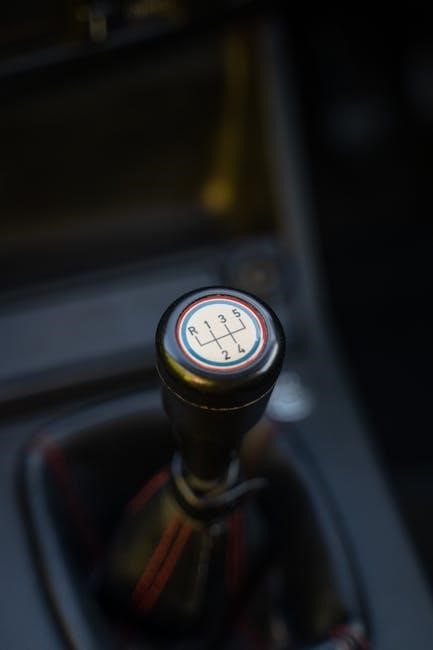The 4l60e transmission is a series of automatic transmissions introduced by General Motors, with a comprehensive guide available for swapping to manual transmission, using various online resources and forums for research purposes daily.
Overview of the Transmission
The 4l60e transmission is an automatic transmission that was introduced by General Motors in 1993, and it has been used in a variety of vehicles, including cars, trucks, and SUVs.
The transmission is a four-speed automatic, with a lock-up torque converter and a variety of gear ratios to provide smooth and efficient shifting.
The 4l60e transmission is known for its reliability and durability, and it has been used in many different vehicles over the years.
It is also a popular choice for swapping to a manual transmission, as it is relatively easy to modify and can be used with a variety of different engines and transmissions.
The transmission is controlled by a computer system that monitors the vehicle’s speed, throttle position, and other factors to determine the optimal gear ratio.
This allows the transmission to provide smooth and efficient shifting, and to help improve the vehicle’s fuel efficiency and performance.
Overall, the 4l60e transmission is a reliable and versatile transmission that has been used in many different vehicles, and it continues to be a popular choice for those looking to swap to a manual transmission.
The transmission’s design and functionality make it an ideal choice for a variety of different applications.
It is a complex system that requires careful consideration and planning to modify or repair.
The 4l60e transmission is an important component of many vehicles, and its proper functioning is essential for safe and efficient operation.

History and Features of the 4L60E Transmission
The 4L60E transmission was introduced by General Motors in 1993 with improved features and functionality for various vehicles and applications daily using online resources.
Evolution of the Transmission
The evolution of the 4L60E transmission has been a gradual process, with various improvements and upgrades made over the years to enhance its performance and functionality.
The transmission has undergone significant changes, from its introduction in 1993 to the present day, with a focus on improving its reliability, durability, and overall efficiency.
The use of advanced materials and technologies has played a crucial role in the transmission’s evolution, enabling it to meet the changing needs of the automotive industry.
As a result, the 4L60E transmission has become a popular choice for many vehicle owners, offering a range of benefits, including improved fuel efficiency, reduced maintenance costs, and enhanced driving experience.
The transmission’s evolution has also been influenced by the growing demand for manual transmissions, with many owners opting to swap their automatic transmissions for manual ones to improve performance and control.
Overall, the evolution of the 4L60E transmission has been shaped by a combination of technological advancements, changing consumer needs, and the ongoing pursuit of innovation and improvement in the automotive industry.
The transmission’s development has been marked by significant milestones, each representing a major step forward in its evolution.
The 4L60E transmission has come a long way since its introduction, and its continued evolution is likely to shape the future of the automotive industry.
Its impact on the industry has been significant, and it will be interesting to see how it continues to evolve in the years to come.
The transmission’s evolution is a testament to the power of innovation and the importance of continuous improvement in the automotive industry.

Swapping the 4L60E Transmission to a Manual Transmission
Transmission swapping involves replacing the 4L60E with a manual transmission, requiring careful planning and execution using online resources and forums for guidance and support daily always.
Guide for Swapping Transmissions
A comprehensive guide for swapping transmissions is essential for a successful conversion, providing detailed instructions and recommendations for each step of the process. The guide should include information on the necessary tools and materials, as well as troubleshooting tips and common pitfalls to avoid. By following a well-structured guide, individuals can ensure a smooth and reliable transmission upgrade, minimizing the risk of errors and potential damage to the vehicle. Additionally, the guide should cover the importance of proper installation, adjustment, and testing of the new transmission, as well as any necessary modifications to the vehicle’s electrical and mechanical systems. With a thorough guide, individuals can confidently navigate the transmission swapping process, achieving a successful and satisfying outcome. The guide should be based on real-world experience and expert knowledge, providing a valuable resource for those undertaking this complex project, and helping to ensure a successful and reliable transmission upgrade.

Modifications and Procedures for the Swap
Various mechanical and electrical modifications are necessary for a successful transmission swap using online resources.
Actual Modifications and Procedures
The process of swapping a 4l60e transmission to a manual transmission involves several key steps and modifications.
Firstly, the transmission pan must be removed to access the valve body and other internal components.
The valve body is then modified to accommodate the manual transmission’s shift mechanism.
Additionally, the hydraulic system must be upgraded to handle the increased pressure and flow requirements of the manual transmission.
This typically involves installing a new hydraulic pump and modifying the existing hydraulic lines.
The transmission’s electrical system must also be modified to work with the manual transmission’s control module.
A new wiring harness and control module must be installed, and the existing wiring must be modified to connect to the new components.
The transmission’s mounts and crossmember must also be modified to accommodate the manual transmission’s different shape and size.
Overall, the process of swapping a 4l60e transmission to a manual transmission is complex and requires careful planning and execution.
It is recommended that only experienced mechanics attempt this swap, as it requires a high level of technical expertise and specialized tools.
The end result, however, can be well worth the effort, as a manual transmission can provide improved performance and driving dynamics.

and Final Thoughts
A successful 4l60e manual transmission swap requires careful planning and execution with online resources and forums providing valuable guidance and support daily always.
Ultimate Guide for a Smooth and Reliable Transmission Upgrade
To achieve a smooth and reliable transmission upgrade, it is essential to have a comprehensive guide that outlines the necessary steps and procedures. The internet provides a wealth of information on the topic, including detailed instructions and forums where individuals can share their experiences and offer advice. By carefully planning and executing the swap, individuals can ensure a successful outcome and enjoy the benefits of a manual transmission. The guide should include information on the mechanical and electrical differences between transmission years and models, as well as the modifications needed to swap transmissions between different vehicle platforms. Additionally, the guide should provide tips and recommendations for troubleshooting common issues and optimizing the performance of the transmission. With the right guidance and support, individuals can confidently navigate the process of upgrading their transmission and enjoy the improved performance and reliability that comes with it. The guide is an invaluable resource for anyone looking to upgrade their transmission.




Leave a Reply
You must be logged in to post a comment.